MAZDA MODEL 6 2008 Owners Manual (in English)
Manufacturer: MAZDA, Model Year: 2008, Model line: MODEL 6, Model: MAZDA MODEL 6 2008Pages: 440, PDF Size: 6.49 MB
Page 141 of 440

Black plate (141,1)
qTransaxle Ranges
The shift lever must be in P or N to
operate the starter.
P (Park)
P locks the transaxle and prevents the
front wheels from rotating.
WARNING
Always set the shift lever to P and set
the parking brake:
Only setting the shift lever to the P
position without using the parking
brake to hold the vehicle is
dangerous. If P fails to hold, the
vehicle could move and cause an
accident.
CAUTION
ØShifting into P, N or R while the
vehicle is moving can damage
your transaxle.
Ø Shifting into a driving gear or
reverse when the engine is running
faster than idle can damage the
transaxle.
R (Reverse)
In position R, the vehicle moves only
backward. You must be at a complete stop
before shifting to or from R, except under
rare circumstances as explained in
Rocking the Vehicle (page 4-8).
N (Neutral)
In N, the wheels and transaxle are not
locked. The vehicle will roll freely even
on the slightest incline unless the parking
brake or brakes are on.
WARNING
If the engine is running faster than idle,
do not shift from N or P into a driving
gear:
It's dangerous to shift from N or P
into a driving gear when the engine
is running faster than idle. If this is
done, the vehicle could move
suddenly, causing an accident or
serious injury.
Do not shift into N when driving the
vehicle: Shifting into N while driving is
dangerous. Engine braking cannot be
applied when decelerating which
could lead to an accident or serious
injury.
CAUTION
Do not shift into N when driving the
vehicle. Doing so can cause transaxle
damage.
NOTE
Apply the parking brake or depress the brake
pedal before moving the shift lever from N to
prevent the vehicle from moving unexpectedly.
D (Drive)
D is the normal driving position. From a
stop, the transaxle will automatically shift
through a 5-gear/6-gear
*sequence.
* 3.0-liter engine model
M (Manual)
M is the manual shift mode position.
Gears can be shifted up or down by
operating the shift lever.
Refer to Manual Shift Mode (page 5-14).
Driving Your Mazda
Starting and Driving
5-13
Mazda6_8X47-EA-07G_Edition1 Page141
Tuesday, May 29 2007 3:43 PM
Form No.8X47-EA-07G
Page 142 of 440
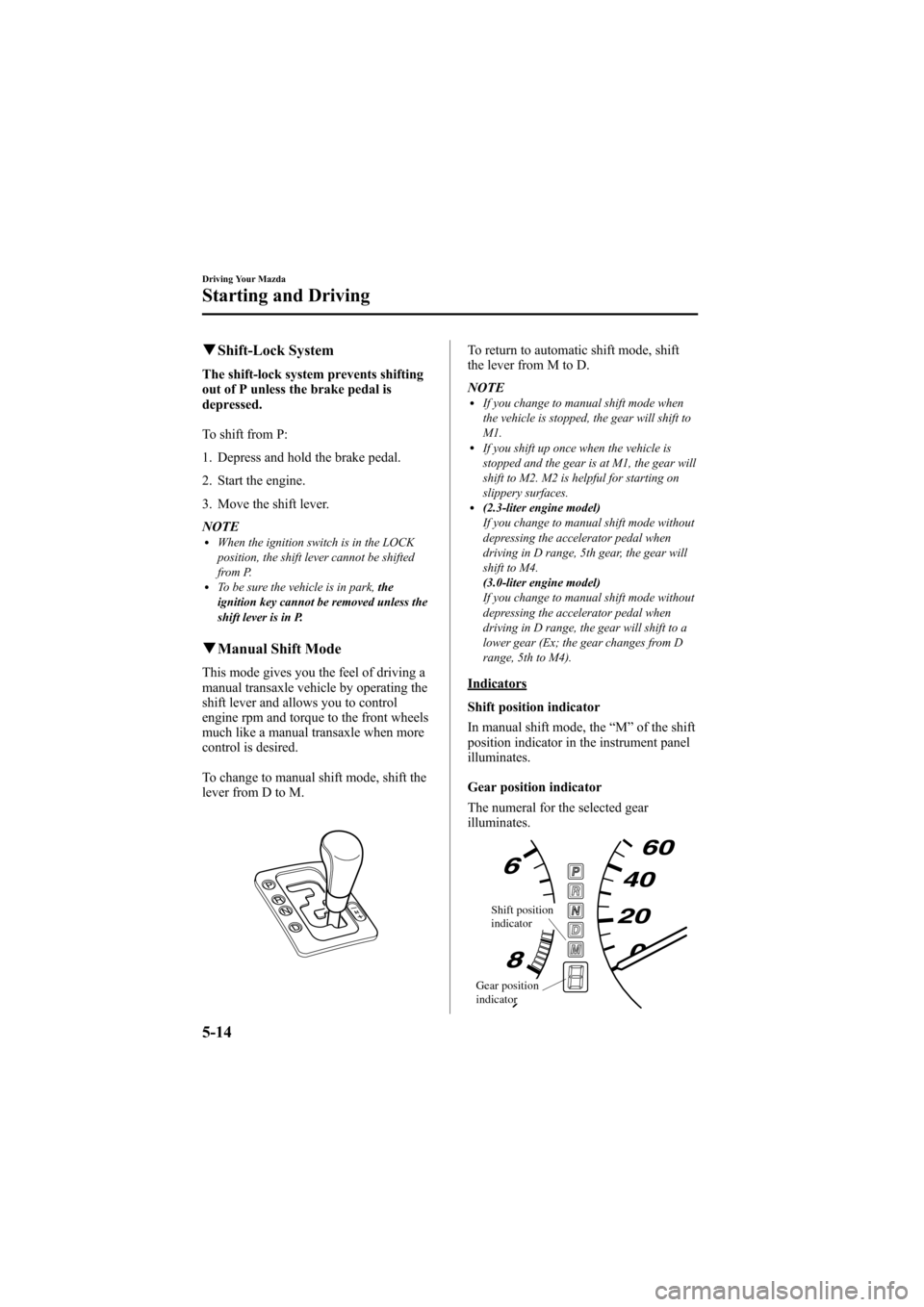
Black plate (142,1)
qShift-Lock System
The shift-lock system prevents shifting
out of P unless the brake pedal is
depressed.
To shift from P:
1. Depress and hold the brake pedal.
2. Start the engine.
3. Move the shift lever.
NOTE
lWhen the ignition switch is in the LOCK
position, the shift lever cannot be shifted
from P.
lTo be sure the vehicle is in park, the
ignition key cannot be removed unless the
shift lever is in P.
q Manual Shift Mode
This mode gives you the feel of driving a
manual transaxle vehicle by operating the
shift lever and allows you to control
engine rpm and torque to the front wheels
much like a manual transaxle when more
control is desired.
To change to manual shift mode, shift the
lever from D to M.
To return to automatic shift mode, shift
the lever from M to D.
NOTE
lIf you change to manual shift mode when
the vehicle is stopped, the gear will shift to
M1.
lIf you shift up once when the vehicle is
stopped and the gear is at M1, the gear will
shift to M2. M2 is helpful for starting on
slippery surfaces.
l(2.3-liter engine model)
If you change to manual shift mode without
depressing the accelerator pedal when
driving in D range, 5th gear, the gear will
shift to M4.
(3.0-liter engine model)
If you change to manual shift mode without
depressing the accelerator pedal when
driving in D range, the gear will shift to a
lower gear (Ex; the gear changes from D
range, 5th to M4).
Indicators
Shift position indicator
In manual shift mode, the “M ”of the shift
position indicator in the instrument panel
illuminates.
Gear position indicator
The numeral for the selected gear
illuminates.
Shift position
indicator
Gear position
indicator
5-14
Driving Your Mazda
Starting and Driving
Mazda6_8X47-EA-07G_Edition1 Page142
Tuesday, May 29 2007 3:43 PM
Form No.8X47-EA-07G
Page 143 of 440

Black plate (143,1)
NOTElIf the gears cannot be shifted down when
driving at higher speeds, the gear position
indicator will flash twice to signal that the
gears cannot be shifted down.
l(2.3-liter engine model)
If the automatic transaxle fluid (ATF)
temperature becomes too high, there is the
possibility that the transaxle will switch to
automatic shift mode, canceling manual
shift mode and turning off the gear position
indicator illumination. This is a normal
function to protect the AT. After the ATF
temperature has decreased, the gear
position indicator illumination turns back
on and driving in manual shift mode is
restored.
Shifting
Manually Shifting up
(M1→M2 →M3 →M4 →M5 →M6
*)
To shift up to a higher gear, tap the shift
lever back (
) once.
* 3.0-liter engine model
NOTElWhen driving slowly, the gears may not
shift up depending on vehicle speed.
lIn manual shift mode, gears do not shift up
automatically. Don't run the engine with the
tachometer needle in the RED ZONE. If the
tachometer needle enters the RED ZONE,
you may feel engine-braking because the
fuel delivery will be stopped to protect the
engine. However, this does not indicate an
abnormality.
lGears may not be shifted from M1 to M2
right after shifting the lever from D to M.
Wait a few seconds and then shift up to M2.
lWhen depressing the accelerator fully, the
transaxle will shift to a lower gear,
depending on vehicle speed.
Manually Shifting down
(M6*→ M5 →M4 →M3 →M2 →M1)
To shift down to a lower gear, tap the shift
lever forward (
) once.
* 3.0-liter engine model
Driving Your Mazda
Starting and Driving
5-15
Mazda6_8X47-EA-07G_Edition1 Page143
Tuesday, May 29 2007 3:43 PM
Form No.8X47-EA-07G
Page 144 of 440
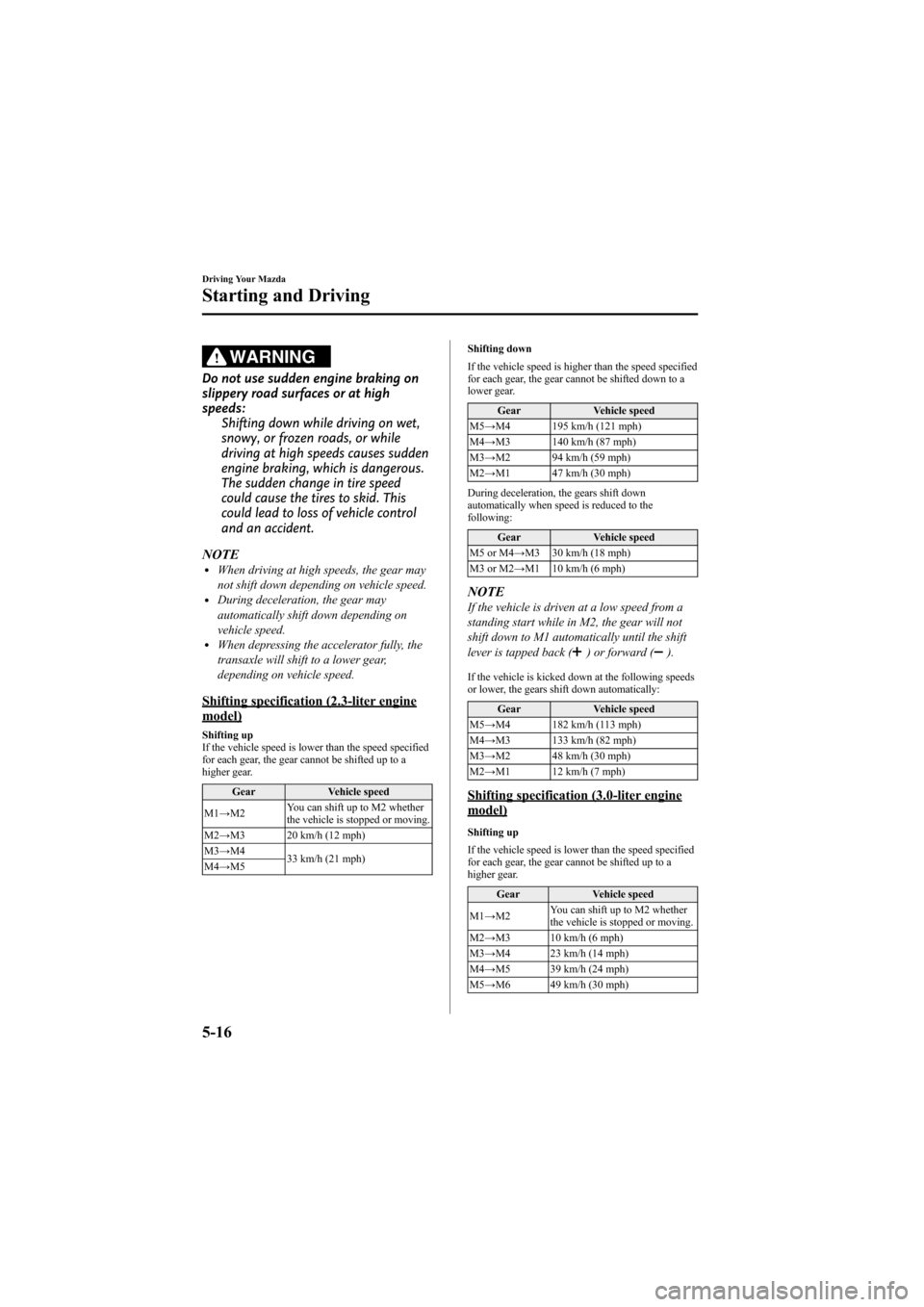
Black plate (144,1)
WARNING
Do not use sudden engine braking on
slippery road surfaces or at high
speeds:Shifting down while driving on wet,
snowy, or frozen roads, or while
driving at high speeds causes sudden
engine braking, which is dangerous.
The sudden change in tire speed
could cause the tires to skid. This
could lead to loss of vehicle control
and an accident.
NOTE
lWhen driving at high speeds, the gear may
not shift down depending on vehicle speed.
lDuring deceleration, the gear may
automatically shift down depending on
vehicle speed.
lWhen depressing the accelerator fully, the
transaxle will shift to a lower gear,
depending on vehicle speed.
Shifting specification (2.3-liter enginemodel)
Shifting up
If the vehicle speed is lower than the speed specified
for each gear, the gear cannot be shifted up to a
higher gear. Gear Vehicle speed
M1 →M2 You can shift up to M2 whether
the vehicle is stopped or moving.
M2 →M3 20 km/h (12 mph)
M3 →M4
33 km/h (21 mph)
M4 →M5 Shifting down
If the vehicle speed is higher than the speed specified
for each gear, the gear cannot be shifted down to a
lower gear.
Gear Vehicle speed
M5 →M4 195 km/h (121 mph)
M4 →M3 140 km/h (87 mph)
M3 →M2 94 km/h (59 mph)
M2 →M1 47 km/h (30 mph)
During deceleration, the gears shift down
automatically when speed is reduced to the
following: Gear Vehicle speed
M5 or M4 →M3 30 km/h (18 mph)
M3 or M2 →M1 10 km/h (6 mph)
NOTEIf the vehicle is driven at a low speed from a
standing start while in M2, the gear will not
shift down to M1 automatically until the shift
lever is tapped back (
) or forward ().
If the vehicle is kicked down at the following speeds
or lower, the gears shift down automatically:
Gear Vehicle speed
M5 →M4 182 km/h (113 mph)
M4 →M3 133 km/h (82 mph)
M3 →M2 48 km/h (30 mph)
M2 →M1 12 km/h (7 mph)
Shifting specification (3.0-liter enginemodel)
Shifting up
If the vehicle speed is lower than the speed specified
for each gear, the gear cannot be shifted up to a
higher gear.
Gear Vehicle speed
M1 →M2 You can shift up to M2 whether
the vehicle is stopped or moving.
M2 →M3 10 km/h (6 mph)
M3 →M4 23 km/h (14 mph)
M4 →M5 39 km/h (24 mph)
M5 →M6 49 km/h (30 mph)
5-16
Driving Your Mazda
Starting and Driving
Mazda6_8X47-EA-07G_Edition1 Page144
Tuesday, May 29 2007 3:43 PM
Form No.8X47-EA-07G
Page 145 of 440

Black plate (145,1)
Shifting down
If the vehicle speed is higher than the speed specified
for each gear, the gear cannot be shifted down to a
lower gear.Gear Vehicle speed
M5 →M4 175 km/h (109 mph)
M4 →M3 130 km/h (81 mph)
M3 →M2 83 km/h (52 mph)
M2 →M1 43 km/h (27 mph)
During deceleration, the gears shift down
automatically when speed is reduced to the
following: Gear Vehicle speed
M6 →M5 50 km/h (31 mph)
M5 →M4 38 km/h (23 mph)
M4 →M3 27 km/h (16 mph)
M3 or M2 →M1 10 km/h (6 mph)
NOTEIf the vehicle is driven at a low speed from a
standing start while in M2, the gear may not
shift down to M1 automatically.
If the vehicle is kicked down at the following speeds
or lower, the gears shift down automatically:
Gear Vehicle speed
M6 →M5 212 km/h (131 mph)
M6 →M4 161 km/h (100 mph)
M5 →M4 161 km/h (100 mph)
M5 →M3 70 km/h (44 mph)
M4 →M3 70 km/h (44 mph)
M4 →M2 46 km/h (28 mph)
M3 →M2 46 km/h (28 mph)
Recommendations for shifting
Upshifting
For normal acceleration and cruising, we recommend
these shift points.
(2.3-liter engine model)
Gear Vehicle speed
M1 to M2 24 km/h (15 mph)
M2 to M3 40 km/h (25 mph)
M3 to M4 65 km/h (40 mph)
M4 to M5 73 km/h (45 mph)
(3.0-liter engine model) Gear Vehicle speed
M1 to M2 24 km/h (15 mph)
M2 to M3 40 km/h (25 mph)
M3 to M4 65 km/h (40 mph)
M4 to M5 73 km/h (45 mph)
M5 to M6 80 km/h (50 mph)
Downshifting
When you must slow down in heavy
traffic or on a steep upgrade, downshift
before the engine starts to overwork. This
gives better acceleration when you need
more speed.
On a steep downgrade , downshifting
helps maintain safe speed and prolongs
brake life.
q Driving Tips
Passing
For extra power when passing another
vehicle or climbing steep grades, depress
the accelerator fully. The transaxle will
shift to a lower gear, depending on vehicle
speed.
Climbing steep grades from a stop
To climb a steep grade from a stopped
position:
1. Depress the brake pedal.
Driving Your Mazda
Starting and Driving
5-17
Mazda6_8X47-EA-07G_Edition1 Page145
Tuesday, May 29 2007 3:43 PM
Form No.8X47-EA-07G
Page 146 of 440
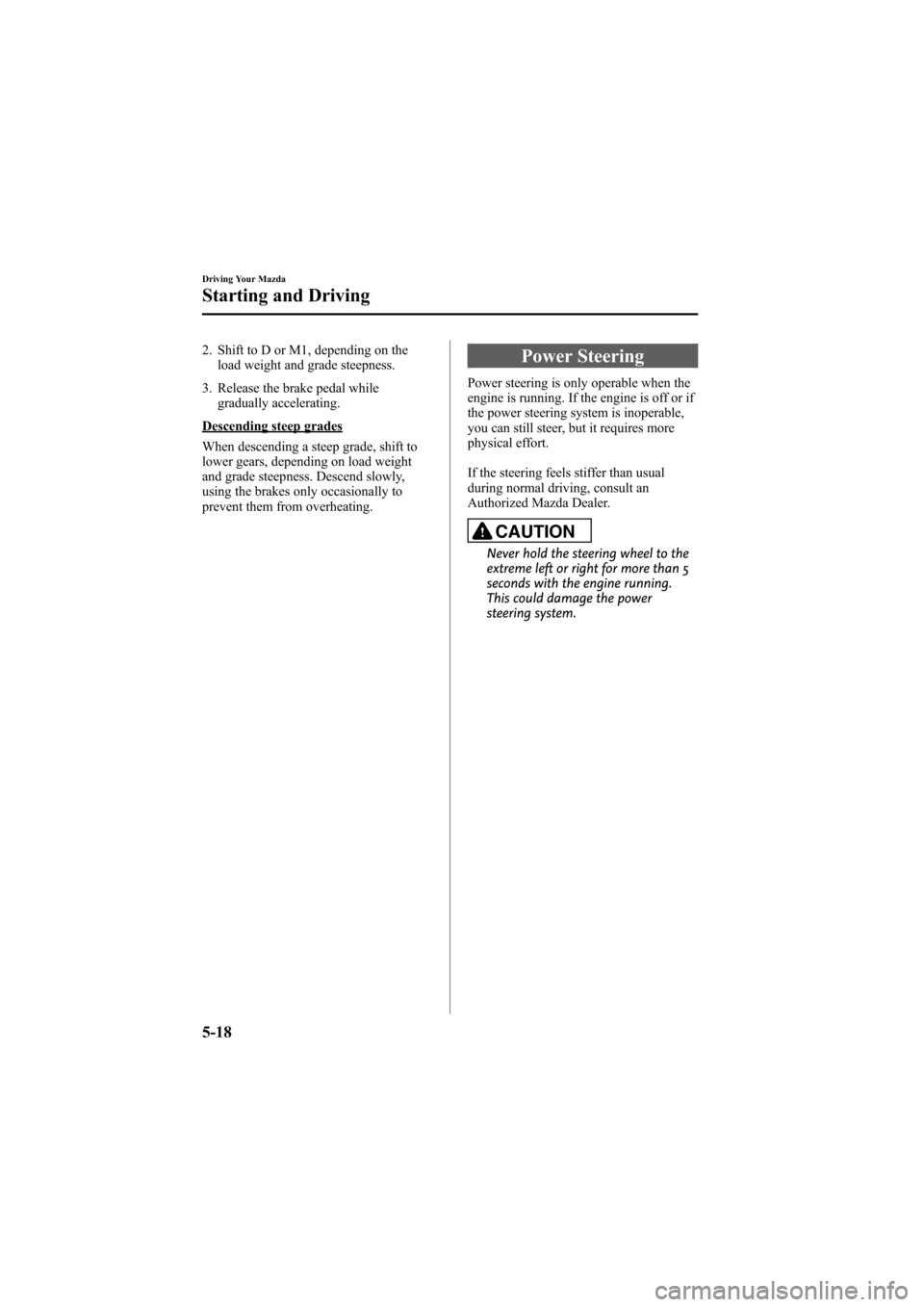
Black plate (146,1)
2. Shift to D or M1, depending on theload weight and grade steepness.
3. Release the brake pedal while gradually accelerating.
Descending steep grades
When descending a steep grade, shift to
lower gears, depending on load weight
and grade steepness. Descend slowly,
using the brakes only occasionally to
prevent them from overheating.
Power Steering
Power steering is only operable when the
engine is running. If the engine is off or if
the power steering system is inoperable,
you can still steer, but it requires more
physical effort.
If the steering feels stiffer than usual
during normal driving, consult an
Authorized Mazda Dealer.
CAUTION
Never hold the steering wheel to the
extreme left or right for more than 5
seconds with the engine running.
This could damage the power
steering system.
5-18
Driving Your Mazda
Starting and Driving
Mazda6_8X47-EA-07G_Edition1 Page146
Tuesday, May 29 2007 3:43 PM
Form No.8X47-EA-07G
Page 147 of 440

Black plate (147,1)
Cruise Control
With cruise control, you can set and
automatically maintain any speed of more
than about 30 km/h (19 mph).
WARNING
Do not use the cruise control under the
following conditions:Using the cruise control under the
following conditions is dangerous
and could result in loss of vehicle
control.
ØHilly terrain
Ø Steep inclines
Ø Heavy or unsteady traffic
Ø Slippery or winding roads
Ø Similar restrictions that require
inconsistent speed
qCruise Main Indicator Light
This light comes on when the ON/OFF
switch is pressed and the cruise control
system is activated.
qCruise Set Indicator Light
This light comes on when a cruising speed
is set.
qActivation/Deactivation
To activate the system, press the ON/OFF
switch.
The cruise main indicator light
illuminates.
To deactivate the system, press the switch
again.
The cruise main indicator light turns off.
WARNING
Keep the ON/OFF switch off when
cruise control is not in use:
Leaving the ON/OFF switch on when
not using the cruise control is
dangerous as you may hit one of the
other buttons and put the vehicle in
cruise control unexpectedly. This
could result in loss of vehicle control.
qTo Set Speed
1. Activate the cruise control system by
pressing the ON/OFF switch.
2. Accelerate to the desired speed, which must be more than 30 km/h (19 mph).
Driving Your Mazda
Starting and Driving
5-19
Mazda6_8X47-EA-07G_Edition1 Page147
Tuesday, May 29 2007 3:43 PM
Form No.8X47-EA-07G
Page 148 of 440
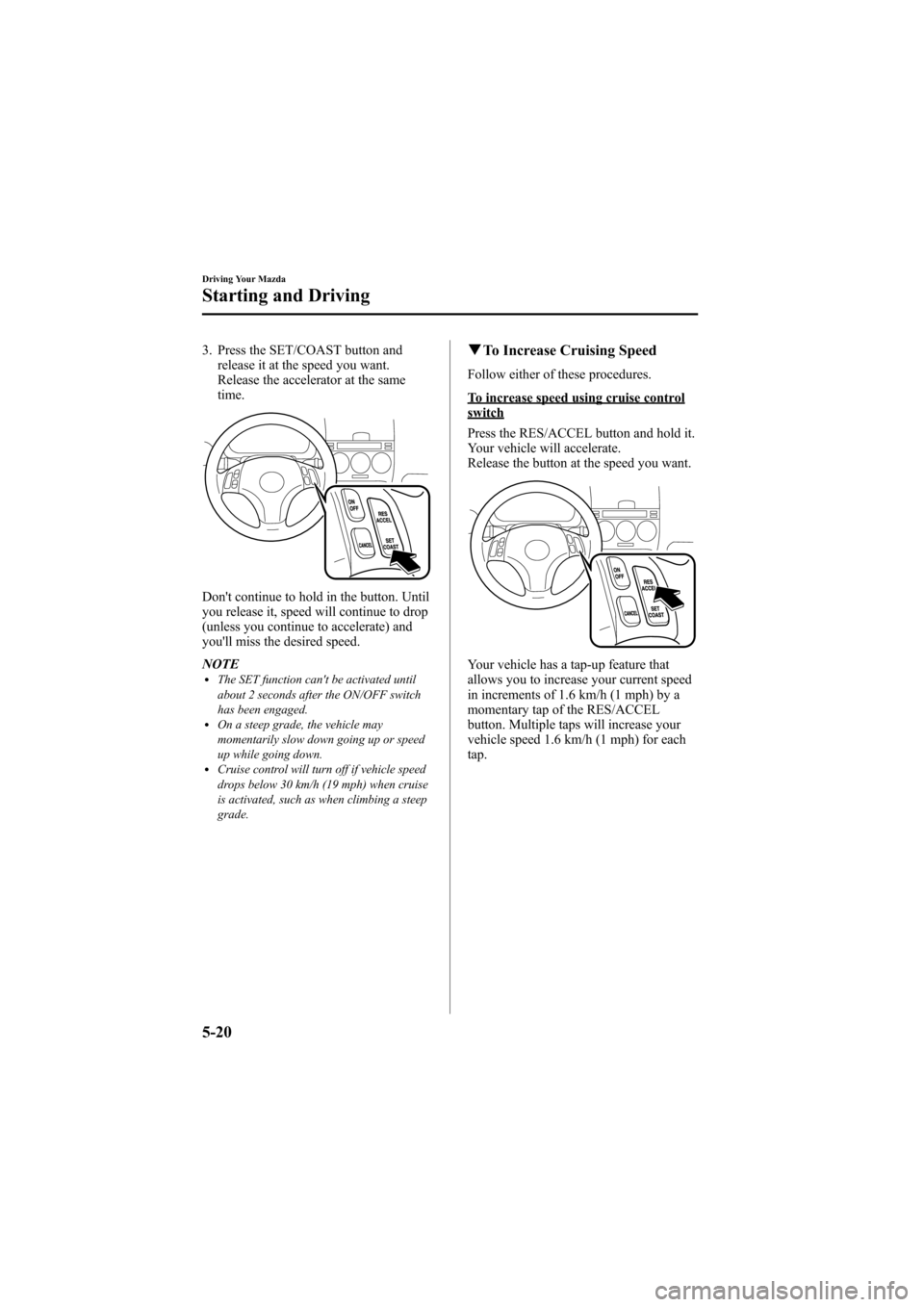
Black plate (148,1)
3. Press the SET/COAST button andrelease it at the speed you want.
Release the accelerator at the same
time.
Don't continue to hold in the button. Until
you release it, speed will continue to drop
(unless you continue to accelerate) and
you'll miss the desired speed.
NOTE
lThe SET function can't be activated until
about 2 seconds after the ON/OFF switch
has been engaged.
lOn a steep grade, the vehicle may
momentarily slow down going up or speed
up while going down.
lCruise control will turn off if vehicle speed
drops below 30 km/h (19 mph) when cruise
is activated, such as when climbing a steep
grade.
qTo Increase Cruising Speed
Follow either of these procedures.
To increase speed using cruise controlswitch
Press the RES/ACCEL button and hold it.
Your vehicle will accelerate.
Release the button at the speed you want.
Your vehicle has a tap-up feature that
allows you to increase your current speed
in increments of 1.6 km/h (1 mph) by a
momentary tap of the RES/ACCEL
button. Multiple taps will increase your
vehicle speed 1.6 km/h (1 mph) for each
tap.
5-20
Driving Your Mazda
Starting and Driving
Mazda6_8X47-EA-07G_Edition1 Page148
Tuesday, May 29 2007 3:43 PM
Form No.8X47-EA-07G
Page 149 of 440
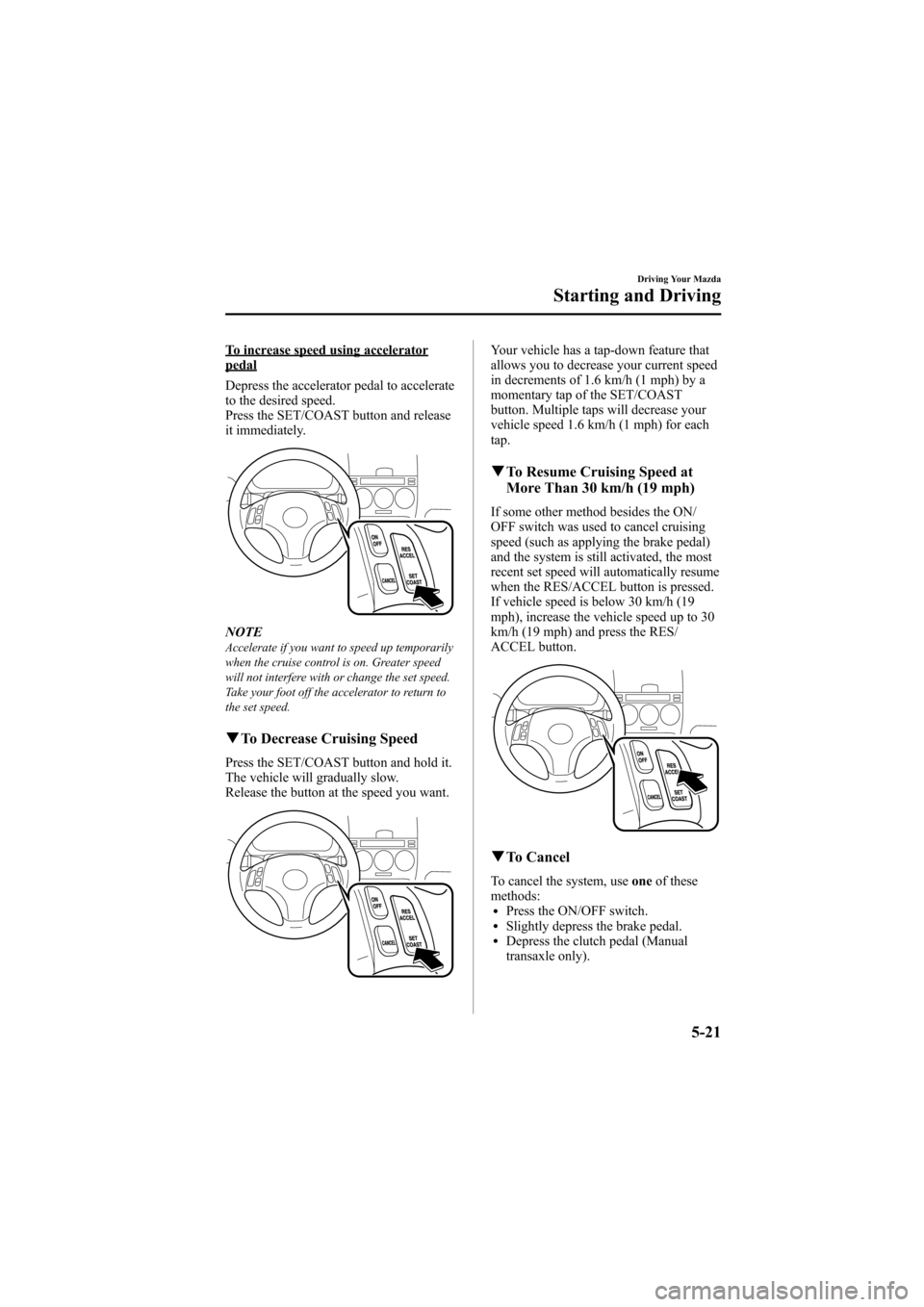
Black plate (149,1)
To increase speed using acceleratorpedal
Depress the accelerator pedal to accelerate
to the desired speed.
Press the SET/COAST button and release
it immediately.
NOTEAccelerate if you want to speed up temporarily
when the cruise control is on. Greater speed
will not interfere with or change the set speed.
Take your foot off the accelerator to return to
the set speed.
qTo Decrease Cruising Speed
Press the SET/COAST button and hold it.
The vehicle will gradually slow.
Release the button at the speed you want.
Your vehicle has a tap-down feature that
allows you to decrease your current speed
in decrements of 1.6 km/h (1 mph) by a
momentary tap of the SET/COAST
button. Multiple taps will decrease your
vehicle speed 1.6 km/h (1 mph) for each
tap.
qTo Resume Cruising Speed at
More Than 30 km/h (19 mph)
If some other method besides the ON/
OFF switch was used to cancel cruising
speed (such as applying the brake pedal)
and the system is still activated, the most
recent set speed will automatically resume
when the RES/ACCEL button is pressed.
If vehicle speed is below 30 km/h (19
mph), increase the vehicle speed up to 30
km/h (19 mph) and press the RES/
ACCEL button.
qTo Cancel
To cancel the system, use oneof these
methods:
lPress the ON/OFF switch.lSlightly depress the brake pedal.lDepress the clutch pedal (Manual
transaxle only).
Driving Your Mazda
Starting and Driving
5-21
Mazda6_8X47-EA-07G_Edition1 Page149
Tuesday, May 29 2007 3:43 PM
Form No.8X47-EA-07G
Page 150 of 440
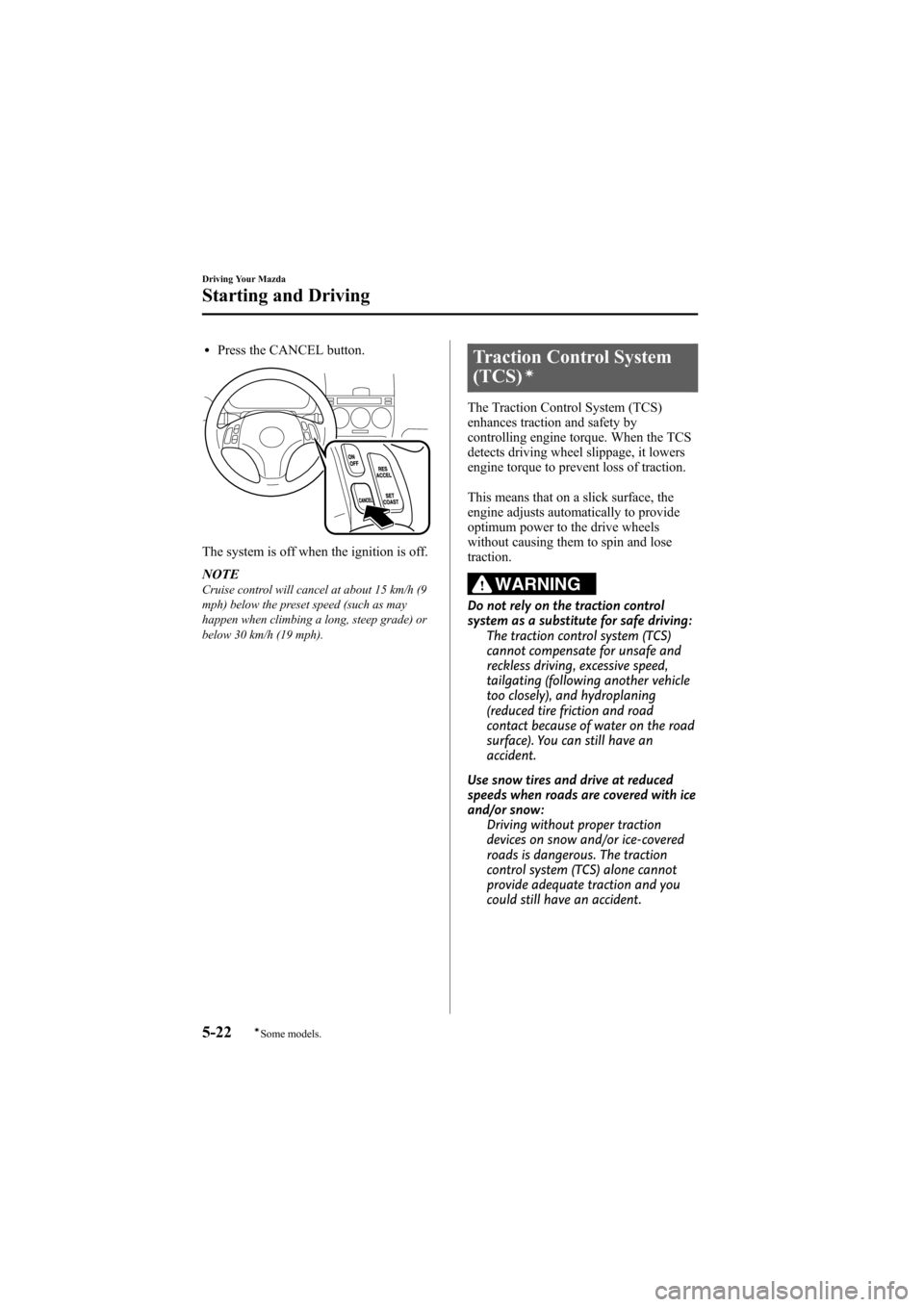
Black plate (150,1)
lPress the CANCEL button.
The system is off when the ignition is off.
NOTE
Cruise control will cancel at about 15 km/h (9
mph) below the preset speed (such as may
happen when climbing a long, steep grade) or
below 30 km/h (19 mph).
Traction Control System
(TCS)í
The Traction Control System (TCS)
enhances traction and safety by
controlling engine torque. When the TCS
detects driving wheel slippage, it lowers
engine torque to prevent loss of traction.
This means that on a slick surface, the
engine adjusts automatically to provide
optimum power to the drive wheels
without causing them to spin and lose
traction.
WARNING
Do not rely on the traction control
system as a substitute for safe driving:The traction control system (TCS)
cannot compensate for unsafe and
reckless driving, excessive speed,
tailgating (following another vehicle
too closely), and hydroplaning
(reduced tire friction and road
contact because of water on the road
surface). You can still have an
accident.
Use snow tires and drive at reduced
speeds when roads are covered with ice
and/or snow: Driving without proper traction
devices on snow and/or ice-covered
roads is dangerous. The traction
control system (TCS) alone cannot
provide adequate traction and you
could still have an accident.
5-22
Driving Your Mazda
íSome models.
Starting and Driving
Mazda6_8X47-EA-07G_Edition1 Page150
Tuesday, May 29 2007 3:43 PM
Form No.8X47-EA-07G